Spatial Distribution and Monitoring of Land Subsidence Using Sentinel-1 SAR Data in Java, Indonesia
Abstract
1. Introduction
2. Data and Methodology
2.1. Study Area
2.2. Data Coverage and Processing
Interferogram Corrections
3. Results
3.1. Spatial Distribution and Land Subsidence Rate
3.1.1. Serang
3.1.2. Greater Jakarta
3.1.3. Cianjur
3.1.4. Bandung Basin
3.1.5. Cirebon
3.1.6. Brebes and Tegal
3.1.7. Pekalongan
3.1.8. Greater Semarang
3.1.9. Surabaya
3.1.10. Sidoardjo
3.2. Comparison with GNSS Observations
4. Discussion
4.1. Impact of Land Subsidence on Java Island
4.2. Spatial Changes in Land Subsidence
4.3. Importance of Land Subsidence Monitoring in Java
5. Conclusions
Author Contributions
Funding
Data Availability Statement
Acknowledgments
Conflicts of Interest
References
- Harintaka, H.; Suhadha, A.G.; Syetiawan, A.; Ardha, M.; Rarasati, A. Current land subsidence in Jakarta: A multi-track SBAS InSAR analysis during 2017–2022 using C-band SAR data. Geocarto Int. 2024, 39, 2364726. [Google Scholar] [CrossRef]
- Bott, L.M.; Schöne, T.; Illigner, J.; Haghshenas Haghighi, M.; Gisevius, K.; Braun, B. Land subsidence in Jakarta and Semarang Bay—The relationship between physical processes, risk perception, and household adaptation. Ocean Coast. Manag. 2021, 211, 105775. [Google Scholar] [CrossRef]
- Gumilar, I.; Sidiq, T.P.; Meilano, I.; Bramanto, B.; Pambudi, G. Extensive Investigation of the Land Subsidence Impressions on Gedebage District, Bandung, Indonesia. IOP Conf. Ser. Earth Environ. Sci. 2021, 873, 12044. [Google Scholar] [CrossRef]
- Bramanto, B.; Breili, K.; Gerlach, C.; Gumilar, I.; Ophaug, V.; Wahyudi, E.J. Geodetic/gravimetric evidence for mass loss in the subsidence area of Bandung, Indonesia. J. Geodyn. 2023, 157, 101987. [Google Scholar] [CrossRef]
- Marfai, M.A.; King, L. Tidal inundation mapping under enhanced land subsidence in Semarang, Central Java Indonesia. Nat. Hazards 2007, 44, 93–109. [Google Scholar] [CrossRef]
- Sarah, D.; Soebowo, E.; Satriyo, N.A. Review of the land subsidence hazard in Pekalongan delta, central Java: Insights from the subsurface. Rud.-Geološko Zb. 2021, 36, 163–176. [Google Scholar] [CrossRef]
- Sidiq, T.P.; Adiwijaya, R.F.; Nugroho, E.O.; Gumilar, I.; Abidin, H.Z. Long term subsidence rate in Pekalongan city observed by SAR Interferometry. IOP Conf. Ser. Earth Environ. Sci. 2023, 1276, 12014. [Google Scholar] [CrossRef]
- Chaussard, E.; Amelung, F.; Abidin, H.; Hong, S.H. Sinking cities in Indonesia: ALOS PALSAR detects rapid subsidence due to groundwater and gas extraction. Remote Sens. Environ. 2013, 128, 150–161. [Google Scholar] [CrossRef]
- Galloway, D.L.; Burbey, T.J. Review: Regional land subsidence accompanying groundwater extraction. Hydrogeol. J. 2011, 19, 1459–1486. [Google Scholar] [CrossRef]
- Bramanto, B.; Gumilar, I.; Sidiq, T.P.; Rahmawan, Y.A.; Abidin, H.Z. Geodetic evidence of land subsidence in Cirebon, Indonesia. Remote Sens. Appl. Soc. Environ. 2023, 30, 100933. [Google Scholar] [CrossRef]
- Susilo, S.; Salman, R.; Hermawan, W.; Widyaningrum, R.; Wibowo, S.T.; Lumban-Gaol, Y.A.; Meilano, I.; Yun, S.H. GNSS land subsidence observations along the northern coastline of Java, Indonesia. Sci. Data 2023, 10, 421. [Google Scholar] [CrossRef] [PubMed]
- Abidin, H.Z.; Andreas, H.; Gamal, M.; Djaja, R.; Subarya, C.; Hirose, K.; Maruyama, Y.; Murdohardono, D.; Rajiyowiryono, H. Monitoring Land Subsidence of Jakarta (Indonesia) Using Leveling, GPS Survey and InSAR Techniques. In A Window on the Future of Geodesy: Proceedings of the International Association of Geodesy IAG General Assembly Sapporo, Japan, 30 June–11 July 2003; Sansò, F., Ed.; Springer: Berlin/Heidelberg, Germany, 2005; pp. 561–566. [Google Scholar]
- Sidiq, T.P.; Gumilar, I.; Meilano, I.; Abidin, H.Z.; Andreas, H.; Permana, A. Land Subsidence of Java North Coast Observed by SAR Interferometry. IOP Conf. Ser. Earth Environ. Sci. 2021, 873, 012078. [Google Scholar] [CrossRef]
- Hasan, M.F.; Smith, R.; Vajedian, S.; Pommerenke, R.; Majumdar, S. Global land subsidence mapping reveals widespread loss of aquifer storage capacity. Nat. Commun. 2023, 14, 6180. [Google Scholar] [CrossRef] [PubMed]
- Wu, P.; Wei, M.; D’Hondt, S. Subsidence in coastal cities throughout the world observed by INSAR. Geophys. Res. Lett. 2022, 49, e2022GL098477. [Google Scholar] [CrossRef]
- Badan Pusat Statistik. Statistical Yearbook of Indonesia 2023; Badan Pusat Statistik: Jakarta, Indonesia, 2023. [Google Scholar]
- van Bemmelen, R. The Geology of Indonesia; Goverment Printing: The Hague, The Netherlands, 1949. [Google Scholar]
- Geological Research and Development Centre of Indonesia. Regional Geological Map, Sheet: Western of Java Scale 1:500,000. 1998. Available online: https://geologi.esdm.go.id/geomap/pages/preview/peta-geologi-lembar-jawa-bagian-barat (accessed on 3 November 2024).
- Geological Research and Development Centre of Indonesia. Regional Geological Map, Sheet: Middle Part of Java Scale 1:500,000. 1999. Available online: https://geologi.esdm.go.id/geomap/pages/preview/peta-geologi-lembar-jawa-bagian-tengah (accessed on 3 November 2024).
- Geological Research and Development Centre of Indonesia. Regional Geological Map, Sheet: Eastern Part of Java Scale 1:500,000. 1999. Available online: https://geologi.esdm.go.id/geomap/pages/preview/peta-geologi-lembar-jawa-bagian-timur (accessed on 3 November 2024).
- Engelen, G.B.; Kloosterman, F.H. Regional Hydrological Systems Analysis in the northern coastal plain of Java, Indonesia. In Hydrological Systems Analysis: Methods and Applications; Springer: Dordrecht, The Netherlands, 1996; pp. 140–144. [Google Scholar] [CrossRef]
- Schmidt, D.A.; Bürgmann, R. Time-dependent land uplift and subsidence in the Santa Clara valley, California, from a large interferometric synthetic aperture radar data set. J. Geophys. Res. Solid Earth 2003, 108, 1–13. [Google Scholar] [CrossRef]
- Pinheiro, M. Increase of Sentinel-1a Orbital Tube: Impact on Interferometry; Technical Note ESA-EOPG-EOPGMQ-TN-2024-12, Issue 1.0, 8 April 2024; European Space Agency (ESA): Frascati, Italy, 2024; pp. 5–14. [Google Scholar]
- Julzarika, A.; Harintaka. Indonesian DEMNAS: DSM or DTM? In Proceedings of the 2019 IEEE Asia-Pacific Conference on Geoscience, Electronics and Remote Sensing Technology (AGERS), Jakarta, Indonesia, 26-27 August 2019; pp. 31–36. [Google Scholar] [CrossRef]
- Susetyo, D.B. Vertical Accuracy Assessment of Various Open-Source Dem Data: Demnas, Srtm-1, and Aster Gdem. Geod. Cartogr. 2023, 49, 209–215. [Google Scholar] [CrossRef]
- Chen, C.W.; Zebker, H.A. Two-dimensional phase unwrapping with use of statistical models for cost functions in nonlinear optimization. J. Opt. Soc. Am. A 2001, 18, 338–351. [Google Scholar] [CrossRef]
- Yu, C.; Li, Z.; Penna, N.T. Interferometric synthetic aperture radar atmospheric correction using a GPS-based iterative tropospheric decomposition model. Remote Sens. Environ. 2018, 204, 109–121. [Google Scholar] [CrossRef]
- Yu, C.; Li, Z.; Penna, N.; Crippa, P. Generic Atmospheric Correction Model for Interferometric Synthetic Aperture Radar Observations. J. Geophys. Res. Solid Earth 2018, 123. [Google Scholar] [CrossRef]
- Agram, P.S.; Simons, M. A noise model for InSAR time series. J. Geophys. Res. Solid Earth 2015, 120, 2752–2771. [Google Scholar] [CrossRef]
- Hanssen, R.F. Radar Interferometry: Data Interpretation and Error Analysis; Springer: Dordrecht, The Netherlands, 2001. [Google Scholar] [CrossRef]
- Liu, Z.; Jung, H.S.; Lu, Z. Joint correction of ionosphere noise and orbital error in L-Band SAR interferometry of interseismic deformation in southern California. IEEE Trans. Geosci. Remote Sens. 2014, 52, 3421–3427. [Google Scholar] [CrossRef]
- Du, Y.; Fu, H.; Liu, L.; Feng, G.; Peng, X.; Wen, D. Orbit error removal in InSAR/MTInSAR with a patch-based polynomial model. Int. J. Appl. Earth Obs. Geoinf. 2021, 102, 102438. [Google Scholar] [CrossRef]
- Fattahi, H.; Amelung, F. DEM Error Correction in InSAR Time Series. IEEE Trans. Geosci. Remote Sens. 2013, 51, 4249–4259. [Google Scholar] [CrossRef]
- Yunjun, Z.; Fattahi, H.; Amelung, F. Small baseline InSAR time series analysis: Unwrapping error correction and noise reduction. Comput. Geosci. 2019, 133, 104331. [Google Scholar] [CrossRef]
- Hu, J.; Li, Z.W.; Ding, X.L.; Zhu, J.J.; Zhang, L.; Sun, Q. Resolving three-dimensional surface displacements from InSAR measurements: A review. Earth-Sci. Rev. 2014, 133, 1–17. [Google Scholar] [CrossRef]
- Aditiya, A.; Ito, T. Present-day land subsidence over Semarang revealed by time series InSAR new small baseline subset technique. Int. J. Appl. Earth Obs. Geoinf. 2023, 125, 103579. [Google Scholar] [CrossRef]
- Sidiq, T.P.; Gumilar, I.; Abidin, H.Z.; Gamal, M. Land subsidence induced by agriculture activity in Bandung, West Java Indonesia. IOP Conf. Ser. Earth Environ. Sci. 2019, 389, 12024. [Google Scholar] [CrossRef]
- Arhatin, R.; Lumban-Gaol, J.; Nurjaya, I.W.; Susilo, S.; Kushardono, D.; Nugroho, U.; Jumarang, M.; Sinurat, M.; Nabil, N. Assessing land subsidence and analyzing tidal flooding in Tangerang, Banten. BIO Web Conf. 2024, 106, 4010. [Google Scholar] [CrossRef]
- Widodo, J.; Herlambang, A.; Sulaiman, A.; Razi, P.; Yohandri; Perissin, D.; Kuze, H.; Sumantyo, J.T.S. Land subsidence rate analysis of Jakarta Metropolitan Region based on D-InSAR processing of Sentinel data C-Band frequency. J. Phys. Conf. Ser. 2019, 1185, 12004. [Google Scholar] [CrossRef]
- BPS-Statistics Bandung Regency. Margahayu District in Figures 2024; BPS-Statistics Bandung Regency: Bandung, Indonesia, 2024; Volume 13. [Google Scholar]
- Ardha, M.; Khomarudin, M.R.; Pranowo, W.S.; Chulafak, G.A.; Yudhatama, D.; Mujio; Pravitasari, S. Spatial information on the rate of subsidence in North Coastal Area of Java and the estimation of inundation in 2031. IOP Conf. Ser. Earth Environ. Sci. 2022, 1109, 12022. [Google Scholar] [CrossRef]
- Solihuddin, T.; Husrin, S.; Mustikasari, E.; Heriati, A.; Kepel, T.L.; Salim, H.L.; Risandi, J.; Dwiyanti, D. Coastal Inundation and Land Subsidence in North Coast of West Java: A New Hazard? IOP Conf. Ser. Earth Environ. Sci. 2021, 925, 12015. [Google Scholar] [CrossRef]
- Pemerintah Provinsi Jawa Tengah. Maksimalkan Irigasi Pertanian, Pemkab Brebes Kucurkan Dana Rp 6 Milyar. 2019. Available online: https://jatengprov.go.id/publik/maksimalkan-irigasi-pertanian-pemkab-brebes-kucurkan-dana-rp-6-milyar (accessed on 2 December 2024).
- Pemerintah Daerah Kabupaten Tegal. Peraturan Daerah Kabupaten Tegal Nomor 4 Tahun 2008 tentang Pengembangan dan Pengelolaan Sistem Irigasi, 2008. Ditetapkan pada 31 Mei 2008, diundangkan pada 3 Juni 2008, dalam LD Kabupaten Tegal Tahun 2008 Nomor 4, TLD Kabupaten Tegal Nomor 19. Available online: https://jdih.tegalkab.go.id/index.php/ProdukHukum/detail/65 (accessed on 24 November 2024).
- Kementerian Departemen Pertanian. Pedoman Teknis Pengembangan Irigasi Tanah Dangkal dan Irigasi Tanah Dalam. Direktorat Pengelolaan Air Irigasi 2011. [Google Scholar]
- Faunt, C.C.; Sneed, M.; Traum, J.A.; Brandt, J.T. Water availability and land subsidence in the Central Valley, California, USA. Hydrogeol. J. 2016, 24, 675–684. [Google Scholar] [CrossRef]
- Nashrrullah, S.; Aprijanto, A.; Pasaribu, J.; Hazarika, M.; Samarakoon, L. Study of flood inundation in pekalongan, central java. Int. J. Remote Sens. Earth Sci. 2013, 10, 76–83. [Google Scholar]
- Sarah, D.; Hutasoit, L.; Delinom, R.; Sadisun, I. Natural Compaction of Semarang-Demak Alluvial Plain and Its Relationship to the Present Land Subsidence. Indones. J. Geosci. 2020, 7, 273–289. [Google Scholar] [CrossRef]
- Andreas, H.; Abidin, H.Z.; Sidiq, T.P.; Gumilar, I.; Aoki, Y.; Hakim, A.L.; Sumintadiredja, P. Understanding the trigger for the LUSI mud volcano eruption from ground deformation signatures. Geol. Soc. London, Spec. Publ. 2017, 441, 199–212. [Google Scholar] [CrossRef]
- Giovanie, Y.; Azzarra, A.B.; Hidayatullah, A.F.; Hariz, A.R. Land Subsidence in the North Coastal Semarang City for Socioeconomic Activities. TEMALI J. Pembang. Sos. 2023, 6, 15–22. [Google Scholar] [CrossRef]
- Prasetyo, Y.; Bashit, N.; Sasmito, B.; Setianingsih, W. Impact of Land Subsidence and Sea Level Rise Influence Shoreline Change in the Coastal Area of Demak. IOP Conf. Ser. Earth Environ. Sci. 2019, 280, 012006. [Google Scholar] [CrossRef]
- Anjasmara, I.M.; Yulyta, S.A.; Cahyadi, M.N.; Khomsin, K.; Taufik, M.; Jaelani, L.M. Land subsidence analysis in Surabaya urban area using time series InSAR method. In Proceedings of the International Symposium on Earth Hazard and Disaster Mitigation, ISEDM 2017: The 7th Annual Symposium on Earthquake and Related Geohazard Research for Disaster Risk Reduction, Bandung, Indonesia, 20–21 November 2017. [Google Scholar] [CrossRef]
- Handoko, E.; Kurniawan, A.; Angger, S. Apakah Surabaya Terjadi Land subsidence? Kajian Awal Land Subsidence Surabaya. Semin. Nas. Apl. Teknol. Prasarana Wil. 2011, 20011, 17–20. [Google Scholar]
- Pamungkas, Y.A.; Chiang, S.H. Monitoring land subsidence induced by groundwater change using satellite gravimetry and radar interferometry measurements. Case study: Surabaya city, Indonesia. IOP Conf. Ser. Earth Environ. Sci. 2021, 916, 12030. [Google Scholar] [CrossRef]
- Riastama, C.N.; Anjasmara, I.M.; Maulida, P. Monitoring Land Subsidence and its Effect on Surabaya Coastal Inundation by Utilizing GPS Campaigns Data. IOP Conf. Ser. Earth Environ. Sci. 2023, 1127, 12002. [Google Scholar] [CrossRef]
- Aoki, Y.; Sidiq, T.P. Ground deformation associated with the eruption of Lumpur Sidoarjo mud volcano, east Java, Indonesia. J. Volcanol. Geotherm. Res. 2014, 278–279, 96–102. [Google Scholar] [CrossRef]
- Fukushima, Y.; Mori, J.; Hashimoto, M.; Kano, Y. Subsidence associated with the LUSI mud eruption, East Java, investigated by SAR interferometry. Mar. Pet. Geol. 2009, 26, 1740–1750. [Google Scholar] [CrossRef]
- Badan Informasi Geospasial. InaCORS BIG: Satu Referensi Pemetaan Indonesia, 1st ed.; Badan Informasi Geospasial: Cibinong, Indonesia, 2025; pp. 12–19. [Google Scholar]
- Andreas, H.; Zainal Abidin, H.; Pradipta, D.; Anggreni Sarsito, D.; Gumilar, I. Insight look the subsidence impact to infrastructures in Jakarta and Semarang area; Key for adaptation and mitigation. MATEC Web Conf. 2018, 147, 1–8. [Google Scholar] [CrossRef][Green Version]
- Dinar, A.; Esteban, E.; Calvo, E.; Herrera, G.; Teatini, P.; Tomás, R.; Li, Y.; Ezquerro, P.; Albiac, J. We lose ground: Global assessment of land subsidence impact extent. Sci. Total Environ. 2021, 786, 147415. [Google Scholar] [CrossRef]
- Belland, M.; Kooy, M.; Zwarteveen, M. Destabilizing the science of soils: Geoscientists as spokespersons for land subsidence in Semarang, Indonesia. Environ. Plan. E Nat. Space 2024, 7, 882–903. [Google Scholar] [CrossRef]
- Purnomo, A.H.; Kurniawan, T.; Farandy, A.R.; Apriliani, T.; Nurlaili; Imron, M.; Sajise, A.J. Revisiting the climate change adaptation strategy of Jakarta’s coastal communities. Ocean Coast. Manag. 2024, 253, 107112. [Google Scholar] [CrossRef]
- Saputra, E.; Spit, T.; Zoomers, A. Living in a Bottomless Pit: Households’ Responses to Land Subsidence, an Example from Indonesia. J. Environ. Prot. 2019, 10, 1–21. [Google Scholar] [CrossRef][Green Version]
- Gumilar, I.; Sidiq, T.P.; Virtriana, R.; Pambudi, G.; Bramanto, B.; Abidin, H.Z. Geodetic observations confirming land subsidence of Bandung Basin, Indonesia, and subsequent building damage. Acta Geod. Et Geophys. 2023, 58, 373–388. [Google Scholar] [CrossRef]
- Adelina, C.; Gamal, A.; Marthanty, D.R. Literature Review: How Does Water Play a Role in Forming Land Value? IOP Conf. Ser. Earth Environ. Sci. 2021, 837, 12011. [Google Scholar] [CrossRef]
- Saputra, E.; Hartmann, T.; Zoomers, A.; Spit, T. Fighting the Ignorance: Public Authorities’ and Land Users’ Responses to Land Subsidence in Indonesia. Am. J. Clim. Change 2017, 6, 1–21. [Google Scholar] [CrossRef]
- Nugroho, E.O.; Juliadi, S.A.; Soekarno, I.; Widyaningtias, W.; Kuntoro, A.A.; Sidiq, T.P.; Nurmalia, S.L.; Widigdo, C. Kajian Banjir dan Perubahan Dasar Sungai Banger Akibat Penutupan Regulator Gate, Kota Pekalongan, Provinsi Jawa Tengah. J. Educ. 2024, 6, 12720–12732. [Google Scholar] [CrossRef]
- Abidin, H.Z.; Djaja, R.; Darmawan, D.; Hadi, S.; Akbar, A.; Rajiyowiryono, H.; Sudibyo, Y.; Meilano, I.; Kasuma, M.A.; Kahar, J.; et al. Land Subsidence of Jakarta (Indonesia) and its Geodetic Monitoring System. Nat. Hazards 2001, 23, 365–387. [Google Scholar] [CrossRef]
- Taftazani, R.; Kazama, S.; Takizawa, S. Spatial Analysis of Groundwater Abstraction and Land Subsidence for Planning the Piped Water Supply in Jakarta, Indonesia. Water 2022, 14, 3197. [Google Scholar] [CrossRef]
- Moe, I.R.; Kure, S.; Januriyadi, N.F.; Farid, M.; Udo, K.; Kazama, S.; Koshimura, S. Effect of Land Subsidence on Flood Inundation in Jakarta, Indonesia. J. Jpn. Soc. Civ. Eng. Ser G (Environmental Res. 2016, 72, 283–289. [Google Scholar] [CrossRef]
- Yuwono, B.D.; Sabri, L.M.; Wijaya, A.P.; Awaluddin, M. Assessment of Flood Risk Induced by Land Subsidence Using Machine Learning. Indones. J. Geogr. 2024, 56, 376–386. [Google Scholar] [CrossRef]
- Sarah, D.; Soebowo, E. Land subsidence threats and its management in the North Coast of Java. IOP Conf. Ser. Earth Environ. Sci. 2018, 118, 12042. [Google Scholar] [CrossRef]
- Putri, S.I.; Syakira, H.; Nugroho, E.O.; Layaliya, H.N.; Soeharno, A.W.; Kusuma, M.S.; Farid, M.; Kuntoro, A.A.; Sidiq, T.P.; Nurmalia, S.L.; et al. An overview of flood risk components: The Land subsidence case of Pekalongan City. E3S Web Conf. 2024, 513, 1001. [Google Scholar] [CrossRef]
- Abidin, H.Z.; Gumilar, I.; Andreas, H.; Murdohardono, D.; Fukuda, Y. On causes and impacts of land subsidence in Bandung Basin, Indonesia. Environ. Earth Sci. 2013, 68, 1545–1553. [Google Scholar] [CrossRef]
- Rusdi, K.; Wibowo, A.; Saraswati, R. Coastline Changes On The Coast of Cirebon Using Landsat. E3s Web Conf. 2020, 202, 15016. [Google Scholar] [CrossRef]
- Galloway, D.; Jones, D.; Ingebritsen, S. Land Subsidence in the United States; US Geological Survey: Reston, VA, USA, 1999; Volume 1182. [Google Scholar]
- Poland, J.F. Guidebook to Studies of Land Subsidence due to Ground-Water Withdrawal; The United Nations Educational, Scientific and Cultural Organization: Paris, France, 1984. [Google Scholar]
- Erkens, G.; Bucx, T.; Dam, R.; de Lange, G.; Lambert, J. Sinking coastal cities. Proc. Int. Assoc. Hydrol. Sci. 2015, 372, 189–198. [Google Scholar] [CrossRef]
- Koster, K.; Lange, G.D.; Harting, R.; de Heer, E.; Middelkoop, H. Characterizing void ratio and compressibility of Holocene peat with CPT for assessing coastal–deltaic subsidence. Q. J. Eng. Geol. Hydrogeol. 2018, 51, 210–218. [Google Scholar] [CrossRef]
- Hall, R.; Morley, C.K. Sundaland basins. In Continent-Ocean Interactions Within East Asian Marginal Seas; American Geophysical Union (AGU): Washington, DC, USA, 2004; Volume 149, pp. 55–85. [Google Scholar] [CrossRef]
- Galloway, D.L.; Hoffmann, J. The application of satellite differential SAR interferometry-derived ground displacements in hydrogeology. Hydrogeol. J. 2007, 15, 133–154. [Google Scholar] [CrossRef]
- López-Quiroz, P.; Doin, M.P.; Tupin, F.; Briole, P.; Nicolas, J.M. Time series analysis of Mexico City subsidence constrained by radar interferometry. J. Appl. Geophys. 2009, 69, 1–15. [Google Scholar] [CrossRef]
- Erban, L.E.; Gorelick, S.M.; Zebker, H.A. Groundwater extraction, land subsidence, and sea-level rise in the Mekong Delta, Vietnam. Environ. Res. Lett. 2014, 9, 84010. [Google Scholar] [CrossRef]
- Carreón-Freyre, D.; Cerca, M.; Ochoa-González, G.; Teatini, P.; Zuñiga, F.R. Shearing along faults and stratigraphic joints controlled by land subsidence in the Valley of Queretaro, Mexico. Hydrogeol. J. 2016, 24, 657–674. [Google Scholar] [CrossRef]
- Teunissen, P. Dynamic Data Processing: Recursive Least-Squares; TU Delft OPEN Publishing: Delft, The Netherlands, 2001. [Google Scholar] [CrossRef]
- Jiang, J.; Zhang, Y. A revisit to block and recursive least squares for parameter estimation. Comput. Electr. Eng. 2004, 30, 403–416. [Google Scholar] [CrossRef]
- Dumortier, F. Theory and practice of recursive identification. Automatica 1985, 21, 499–501. [Google Scholar] [CrossRef]
- Wang, S.; Ding, R. Three-stage recursive least squares parameter estimation for controlled autoregressive autoregressive systems. Appl. Math. Model. 2013, 37, 7489–7497. [Google Scholar] [CrossRef]

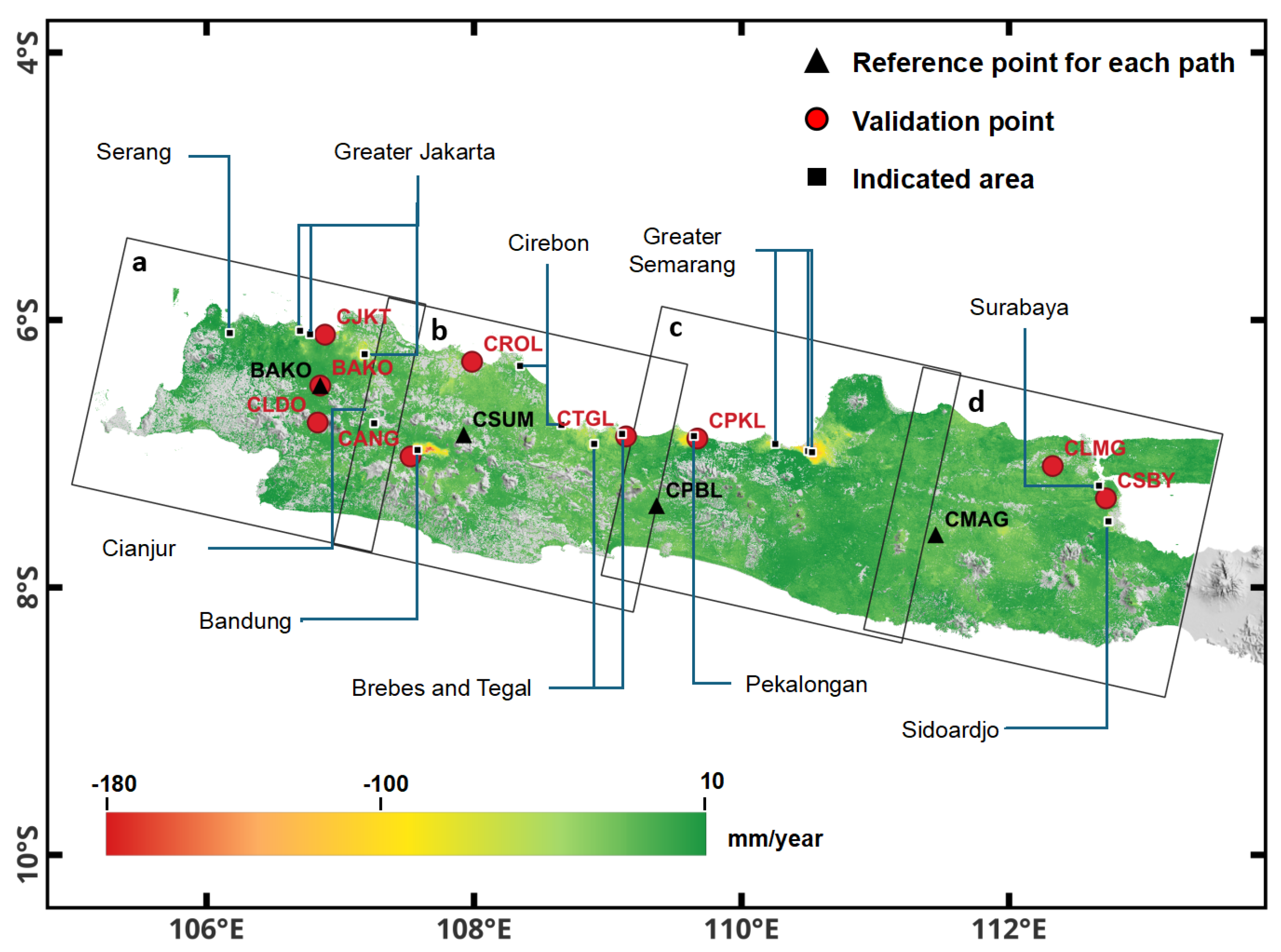

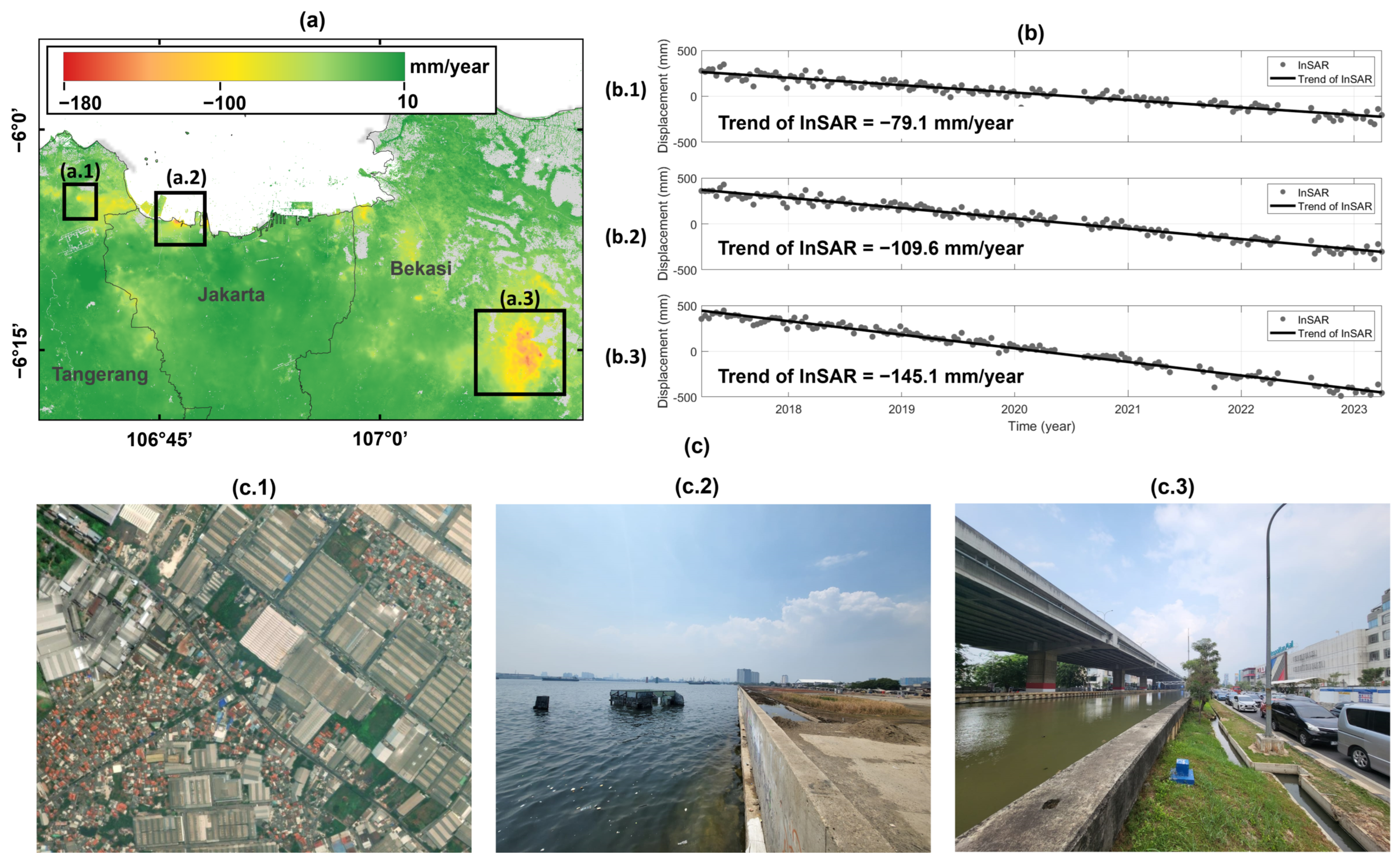
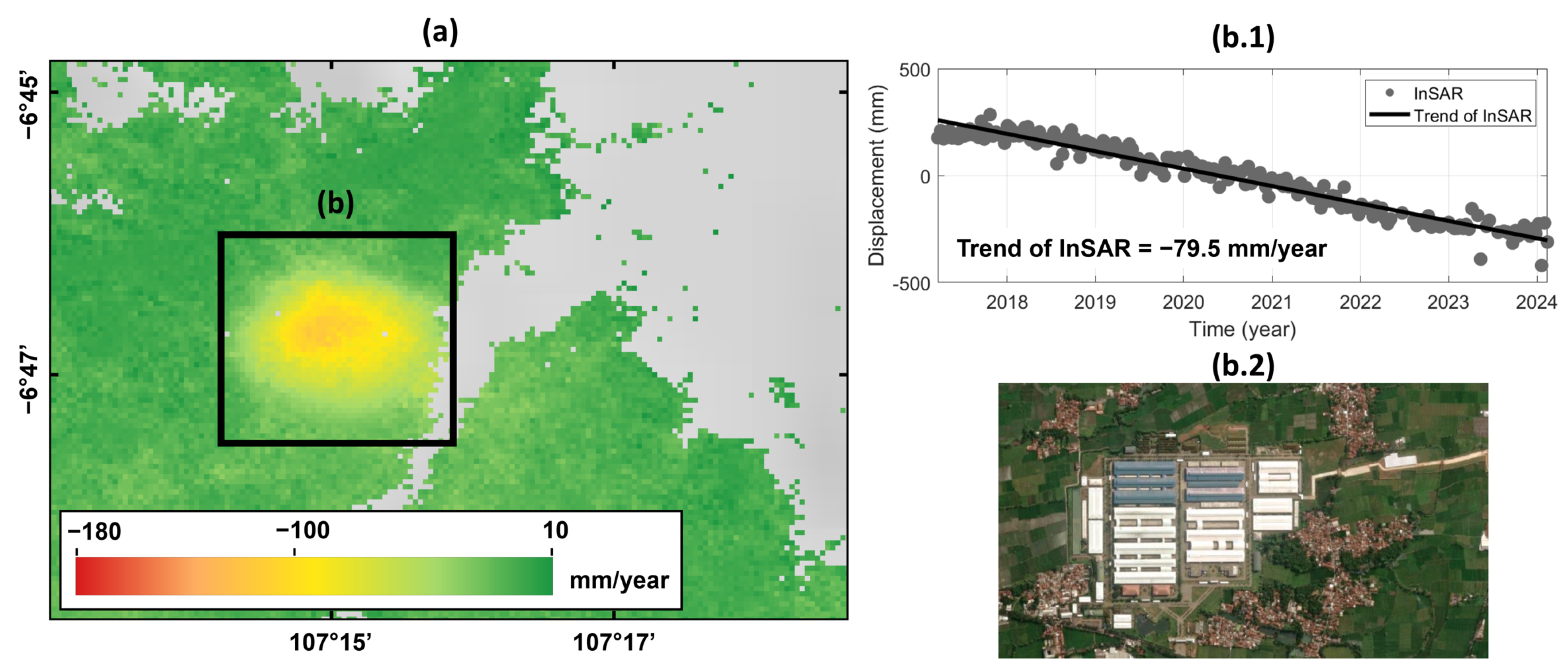

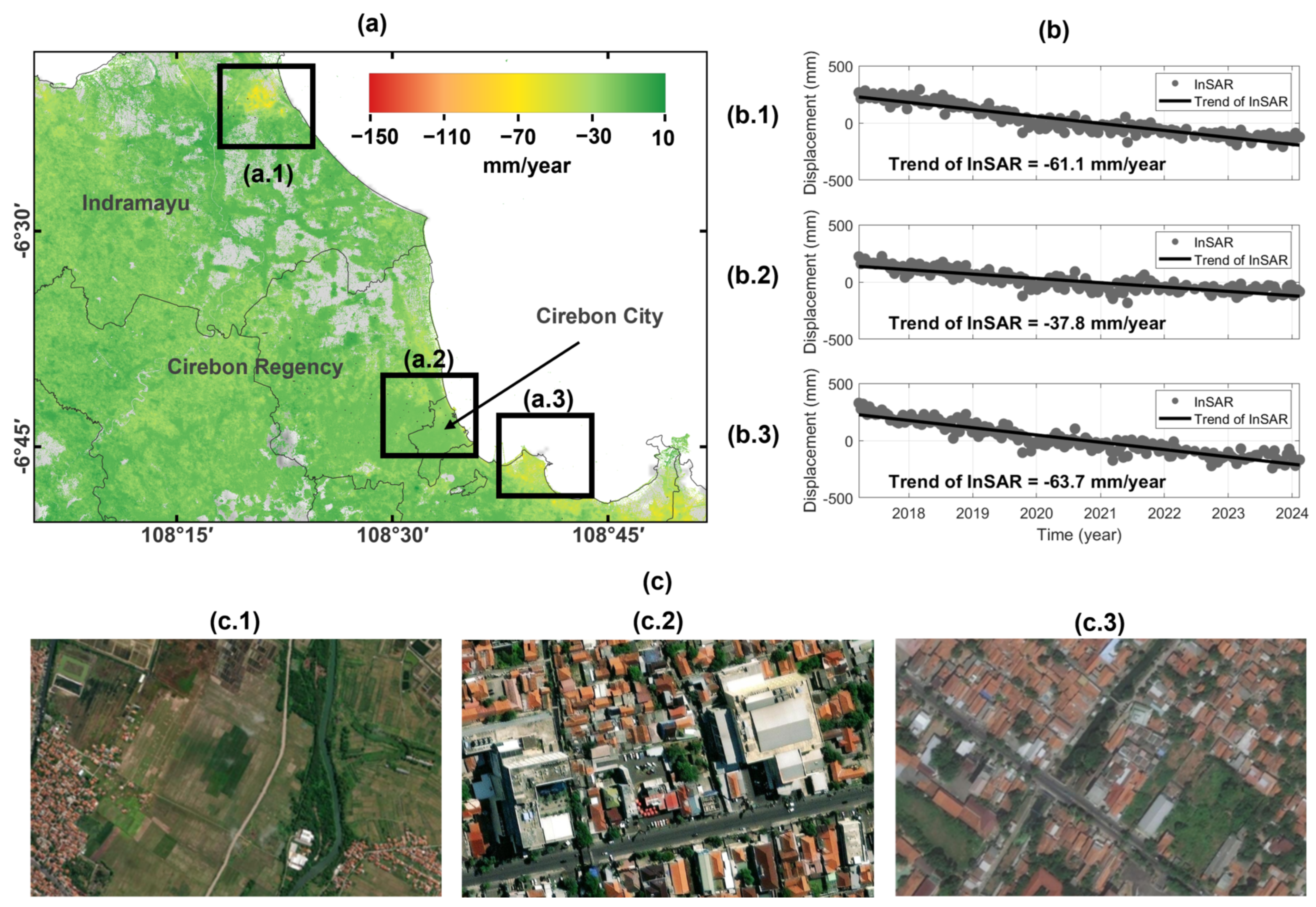
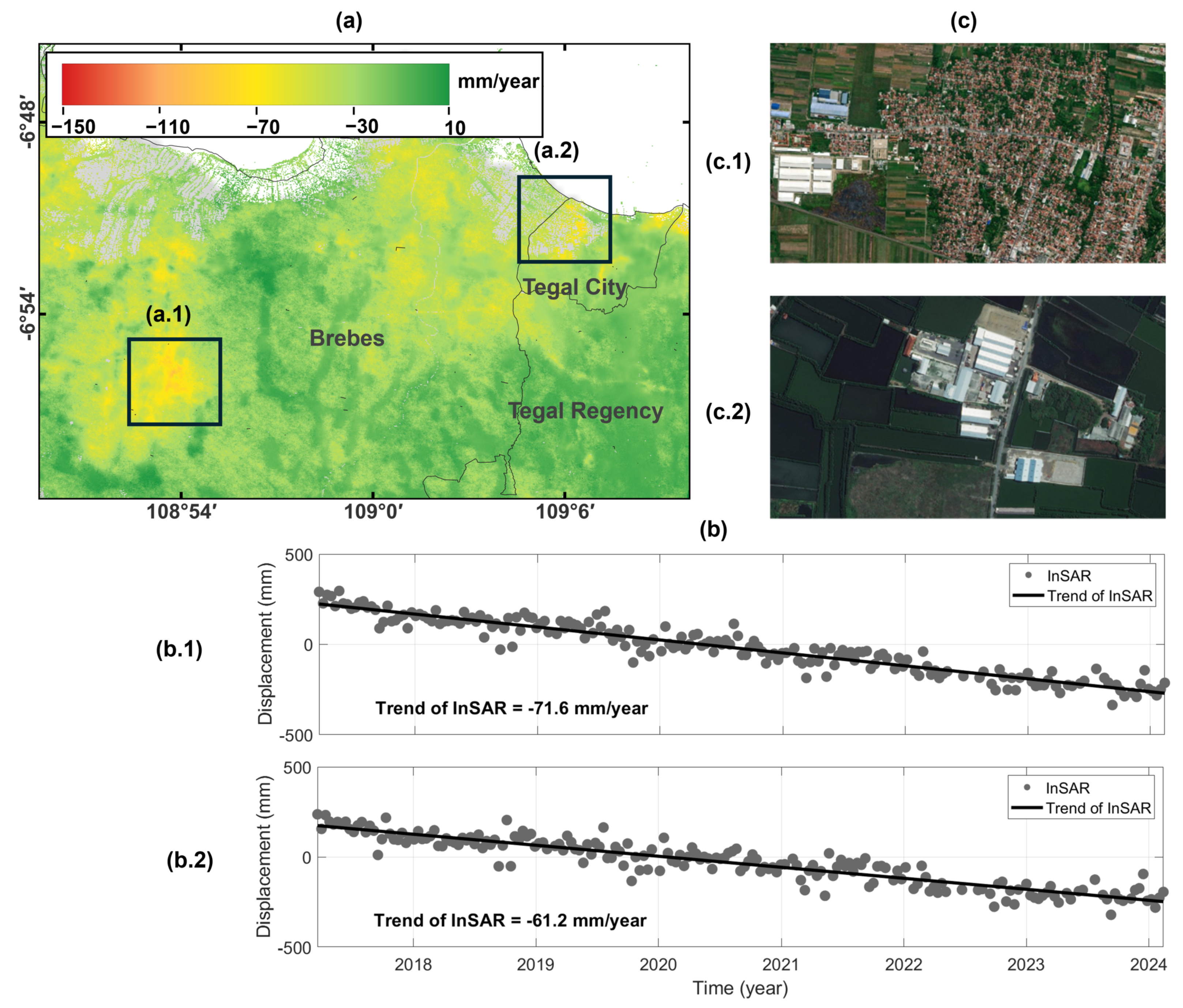
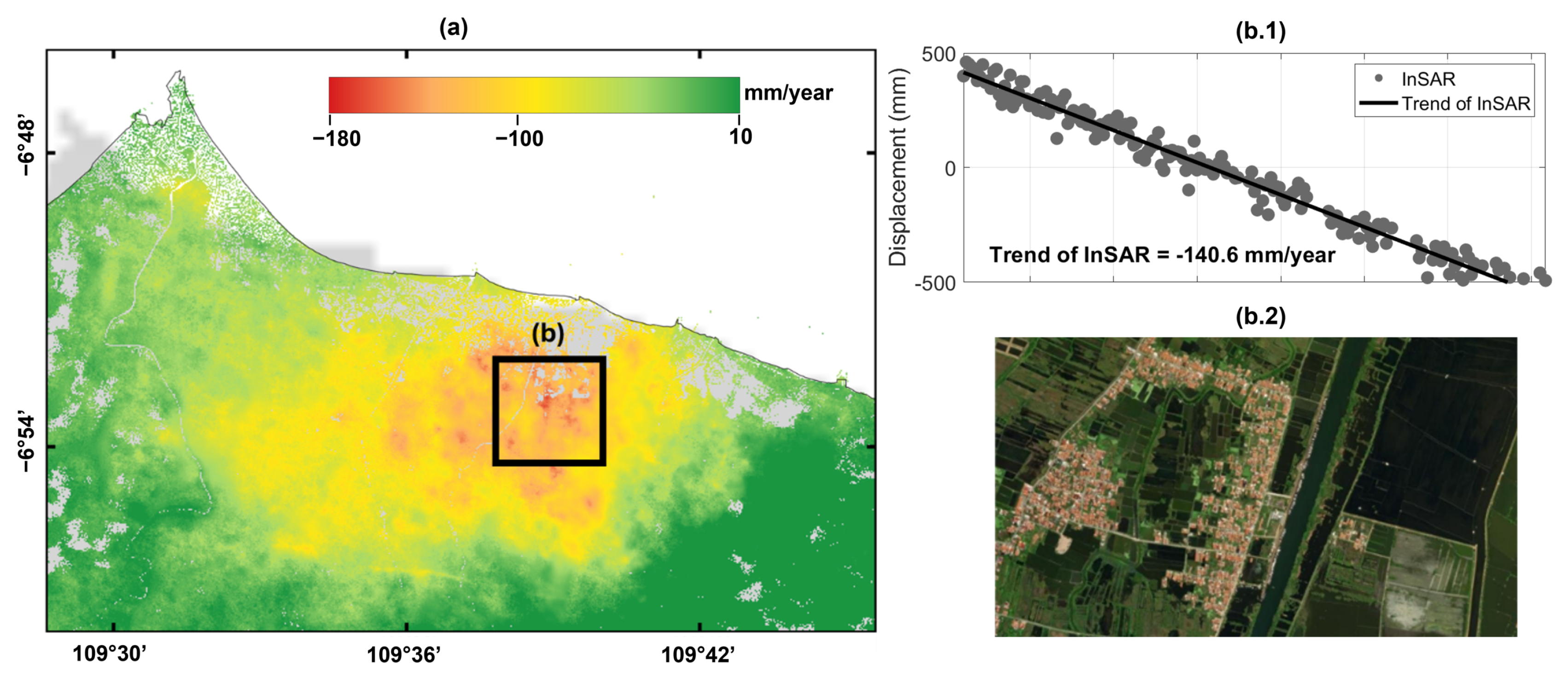


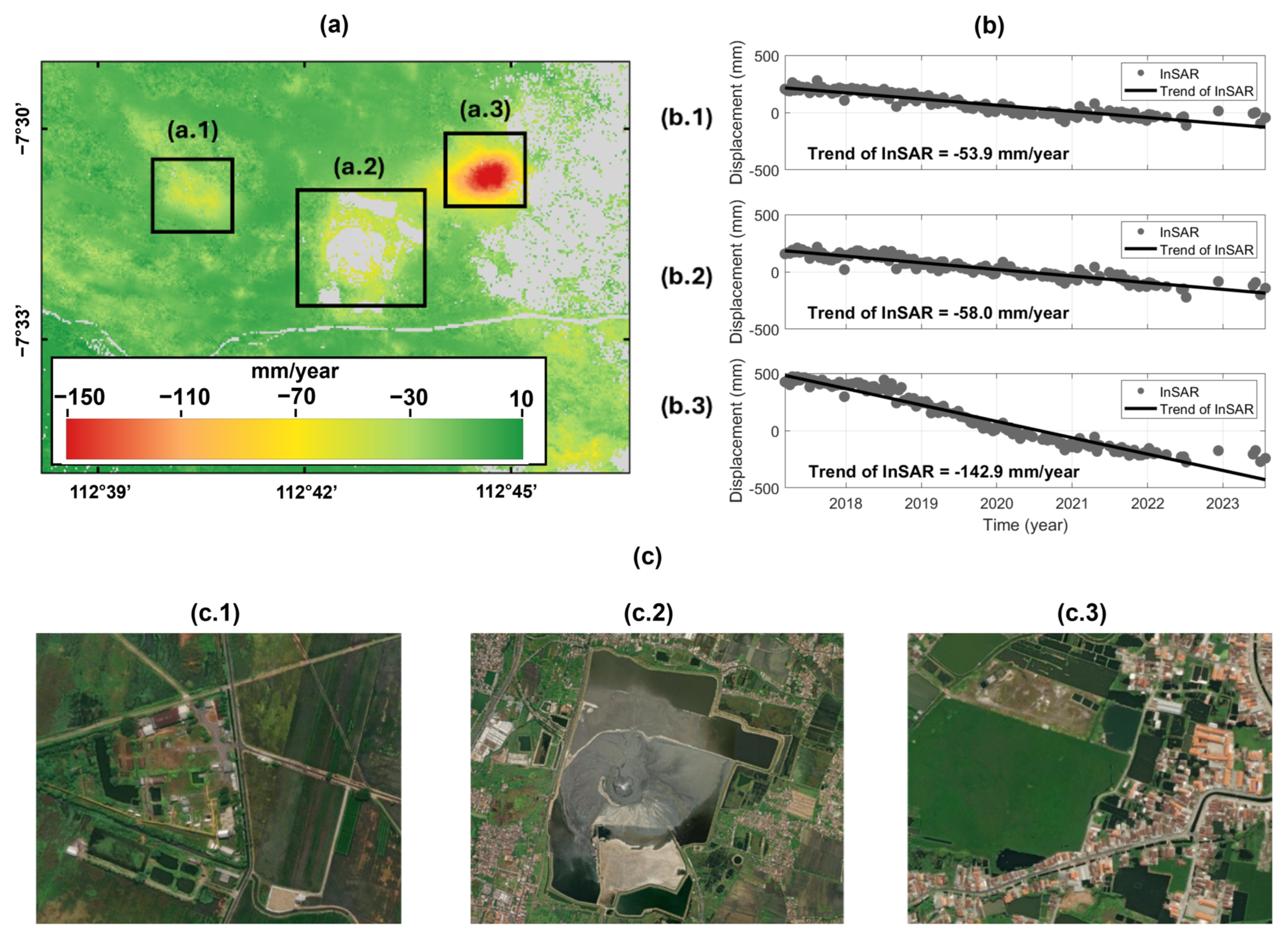
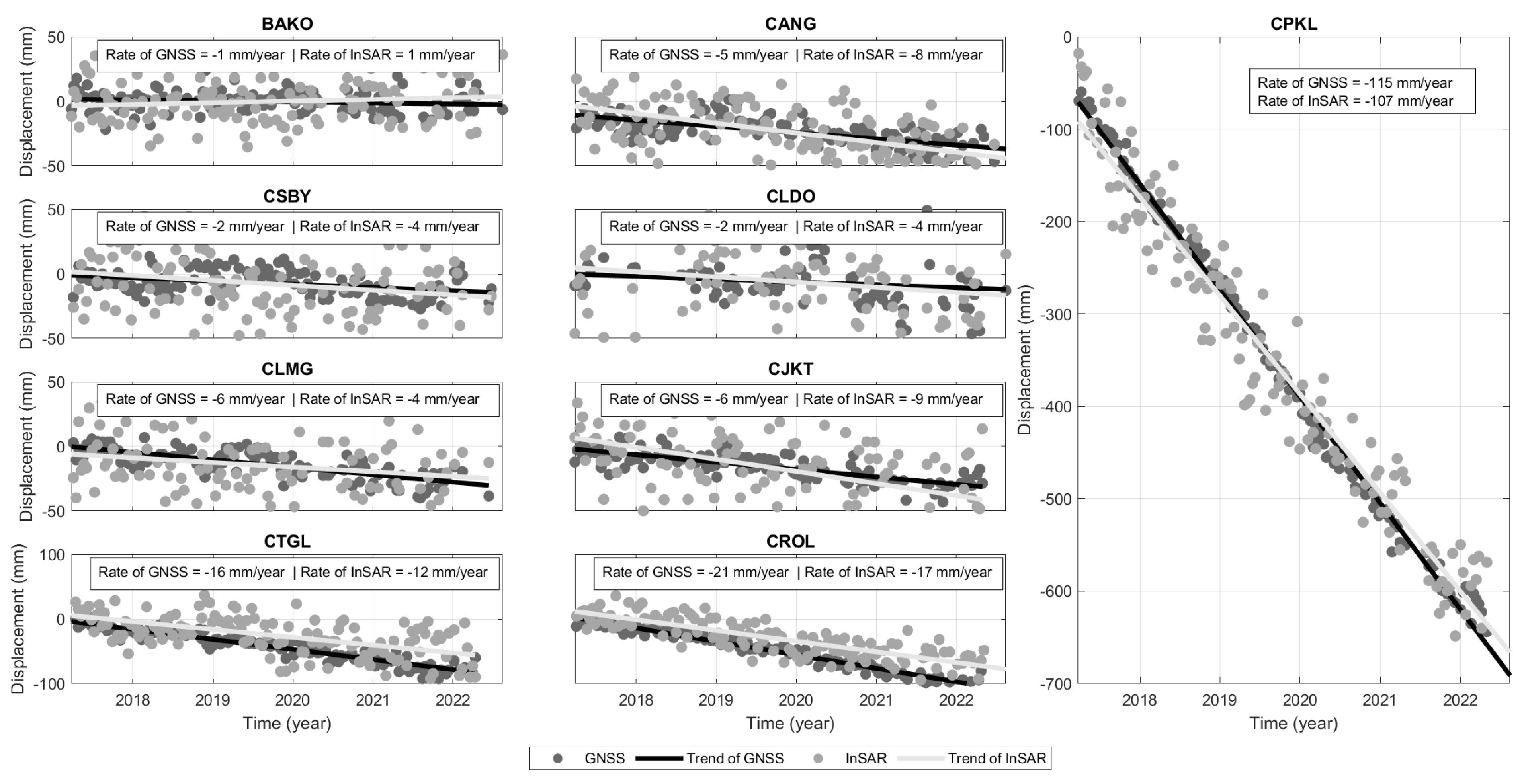

| Aspect | Impacts | Reference(s) |
|---|---|---|
| Social | shift in land use to poorer activities | [59] |
| health problems due o declining water quality | [60] | |
| low adaptation ability to climate change | [61,62] | |
| loss of livelihood | [61,63] | |
| Economy | higher costs to produce good and clean water | [59,60,64] |
| Physical | damage to buildings | [65] |
| loss of high-value transitional areas | [60,66] | |
| decrease in agricultural land | [37] | |
| degradation of drainage system | [12,67] | |
| Environmental | geological-related damage, such as change in both ground- and undergroundwater flow | [10,68] |
| groundwater storage loss | [4,69] | |
| expansion of flood-prone areas | [70,71] | |
| coastal flood and land loss | [2,71] |
| City | Lat (∘) | Lon Lat (∘) | Lithology | LS Rate (mm/Year) | Possible Cause |
|---|---|---|---|---|---|
| Sidoardjo | −7.50605 | 112.74362 | Loose Sediment | 150 | LUSI mud volcano, industrial activities |
| Surabaya | −7.23975 | 112.67260 | Loose Sediment | 73 | High-density development, extensive groundwater extraction, and insufficient drainage systems |
| Demak | −6.98937 | 110.52673 | Loose Sediment | 163 | Extensive groundwater extraction in residential and agricultural areas |
| Semarang | −6.98086 | 110.49777 | Loose Sediment | 174 | Extensive groundwater extraction in residential areas |
| Bandung | −6.97255 | 107.57692 | Loose Sediment | 200 | Extensive groundwater extraction in residential areas |
| Kendal | −6.92732 | 110.25208 | Loose Sediment | 85 | Industrial areas near the port |
| Brebes | −6.92707 | 108.89761 | Loose Sediment | 84 | Densely populated residential areas and agricultural zones |
| Pekalongan | −6.86861 | 109.64359 | Loose Sediment | 145 | Groundwater exploitation and geological condition |
| Tegal | −6.85227 | 109.10610 | Loose Sediment | 77 | Groundwater irrigation network |
| Cirebon | −6.78547 | 108.65221 | Loose Sediment | 67 | Natural compaction processes in areas with thick sedimentary layers and steam power plant |
| Cianjur | −6.77317 | 107.25231 | Volcanic Rocks | 89 | Extensive groundwater extraction in industrial area |
| Indramayu | −6.34368 | 108.34367 | Loose Sediment | 73 | Densely populated residential areas |
| Bekasi | −6.25617 | 107.18126 | Loose Sediment | 140 | Densely populated residential areas |
| Jakarta | −6.10652 | 106.77290 | Loose Sediment | 120 | Densely populated residential areas |
| Banten | −6.09787 | 106.17277 | Loose Sediment | 60 | Excessive groundwater use for residential purposes |
| Tangerang | −6.08126 | 106.69800 | Loose Sediment | 81 | Extensive groundwater extraction in industrial area |
Disclaimer/Publisher’s Note: The statements, opinions and data contained in all publications are solely those of the individual author(s) and contributor(s) and not of MDPI and/or the editor(s). MDPI and/or the editor(s) disclaim responsibility for any injury to people or property resulting from any ideas, methods, instructions or products referred to in the content. |
© 2025 by the authors. Licensee MDPI, Basel, Switzerland. This article is an open access article distributed under the terms and conditions of the Creative Commons Attribution (CC BY) license (https://creativecommons.org/licenses/by/4.0/).
Share and Cite
Sidiq, T.P.; Gumilar, I.; Abidin, H.Z.; Meilano, I.; Purwarianti, A.; Lestari, R. Spatial Distribution and Monitoring of Land Subsidence Using Sentinel-1 SAR Data in Java, Indonesia. Appl. Sci. 2025, 15, 3732. https://doi.org/10.3390/app15073732
Sidiq TP, Gumilar I, Abidin HZ, Meilano I, Purwarianti A, Lestari R. Spatial Distribution and Monitoring of Land Subsidence Using Sentinel-1 SAR Data in Java, Indonesia. Applied Sciences. 2025; 15(7):3732. https://doi.org/10.3390/app15073732
Chicago/Turabian StyleSidiq, Teguh P., Irwan Gumilar, Hasanuddin Z. Abidin, Irwan Meilano, Ayu Purwarianti, and Rahayu Lestari. 2025. "Spatial Distribution and Monitoring of Land Subsidence Using Sentinel-1 SAR Data in Java, Indonesia" Applied Sciences 15, no. 7: 3732. https://doi.org/10.3390/app15073732
APA StyleSidiq, T. P., Gumilar, I., Abidin, H. Z., Meilano, I., Purwarianti, A., & Lestari, R. (2025). Spatial Distribution and Monitoring of Land Subsidence Using Sentinel-1 SAR Data in Java, Indonesia. Applied Sciences, 15(7), 3732. https://doi.org/10.3390/app15073732









